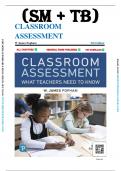EMAIL US ON MEDTESTBANKS@GMAIL.COM
9th Edition
PDF DOWNLOAD
TB)
R
EU
SS
ORIGINAL FROM PUBLISHER
OI
+
NN
ASSESSMENT
CLASSROOM
CO
(SM
ED
W James Popham
ALL CHAPTERS
M
FOR MORE AFFORDABLE FILES CHECK OUT US ON: WWW.MEDTESTBANKS.COM
,M
ED
Instructor’s Resource Manual and Test Bank
for
CO
Classroom Assessment
NN
What Teachers Need to Know
Ninth Edition
OI
W. James Popham
Professor Emeritus, University of California, Los Angeles
SS
EU
(Updated with Distance-Learning Possibilities)
R
, Table of Contents
Introduction ii
Chapter 1 Why Do Teachers Need to Know About Assessment? 1
Chapter 2 Deciding What to Assess 6
Chapter 3 Reliability of Assessment 21
Chapter 4 Validity 24
M
Chapter 5 Fairness 28
ED
Chapter 6 Selected-Response Tests 32
Chapter 7 Constructed-Response Tests 34
CO
Chapter 8 Performance Assessment 36
Chapter 9 Portfolio Assessment 39
NN
Chapter 10 Affective Assessment 41
Chapter 11 Improving Teacher-Developed Assessments 44
OI
Chapter 12 Formative Assessment 47
Chapter 13 Making Sense Out of Standardized Test Scores 50
SS
Chapter 14 Appropriate and Inappropriate Test-Preparation Practices 52
EU
Chapter 15 The Evaluation of Instruction 55
Chapter 16 Assessment-Based Grading 58
R
Mid-Course Examination 60
Final Examination 66
Answer Keys and Item-Chapter Concordance 77
Distance-Learning Possibilities 78
i
, Introduction
INTRODUCTION
A belief exists among many members of the surfing community that “the ninth wave” in
a sequence of ocean waves is apt to be the largest and most powerful of that set of waves. It is
widely held among surfers that a surfboard ride on a ninth wave yields the ultimate rush.
Although many scientists dismiss this belief as mere superstition, I am going to subscribe to a
corollary belief with respect to the ninth edition of any textbook or, more specifically, the book
about which I now write, namely, the ninth edition of Classroom Assessment: What Teachers
Need to Know. Data be damned, I just know that this is the most powerful edition of all its
predecessors.
This is an Instructor's Resource Manual and Test Bank (IRM) for this allegedly potent
M
ninth edition. I'll frequently use a space-saving abbreviation by referring to it as the IRM. What I
intend to do in this introduction is briefly describe what you'll find in this manual. Clearly, an
IRM such as this should make an instructor's tasks easier to perform. So, if you know what's
ED
included in the following pages, you'll surely be able to employ the manual more easily.
Publishers assume, and I suspect they're correct, that busy instructors will typically be
CO
more inclined to adopt a textbook if the textbook is accompanied by resources to simplify the
teaching and testing responsibilities of the instructor. That is the mission of this IRM. I hope it
will be successful. I realize, all too well, that many instructors will have scant use for what you’ll
find in this IRM’s pages. However, if a few instructors pick up a serviceable idea or two from
NN
this document, this will partially justify my personal, flaw-prone typing of the dang thing!
I've used these sorts of IRMs myself on numerous occasions, but those manuals were
invariably prepared by someone other than the author of the text itself. I always had the feeling I
OI
was looking at support materials prepared by a graduate student in search of extra income. Some
of these manuals were quite good. After all, what are graduate students but instructors-in-
waiting? Yet, when it was proposed that an IRM be prepared for the third edition of Classroom
SS
Assessment, I decided I wanted to give it a shot myself. A year or two earlier, I had written my
first IRM for another measurement textbook. That endeavor made me a “seasoned” preparer of
IRMs. Now, having been asked to update this IRM for the new, ninth edition of Classroom
EU
Assessment, I ought to be regarded as an old pro at any IRM-writers’ conclave. You can judge,
after you've used this IRM, whether I should have turned the task over to a graduate student.
In this newly revised edition of Classroom Assessment, you’ll discover that I have
R
dutifully carried out an author’s sacred set of must-do tasks, for instance, making sure that no
sections of the textbook are not in accord with any newly enacted federal statutes or, more likely,
not in accord with any regulations installed to implement such statutes. There was, of course, my
obligatory review of the references supplied with each chapter to make sure that they represent
current, not yesteryear’s measurement thinking. All those routine tasks I have carried out with,
admittedly, less than off-the-wall excitement. But at the same time, there’s something new about
this ninth-wave edition that has me truly turned on. The book contains features permitting its
readers to become active, nay, ardent promoters of increased assessment literacy for educators
and others. Let me explain why I am so jazzed about this possibility imbedded in the ninth
edition.
ii




